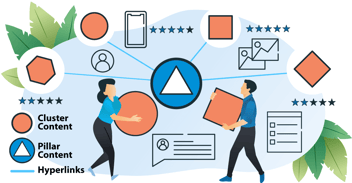支柱页面是搜索引擎优化战略的基础;正确利用支柱页面对谷歌排名至关重要。
支柱页面在单个网页上对某一讨论或主题的所有方面进行高层次但全面的介绍,并通过超链接到支柱页面的更详细的集群博文进行进一步的深入讨论。它们旨在涵盖特定主题的各个方面,足以让您在个人买家旅程中找到更多更深入的信息。

支柱页面为何重要?
-
91%的营销人员表示支柱页面是其搜索引擎优化战略的重要组成部分。 支柱页面应用广泛,可通过吸引反向链接和提高排名有效改善搜索引擎优化。
-
支柱页面可帮助您获得更多关键词的排名。优化良好的支柱页面可帮助您获得各种相关关键词 的 排名,从而提高网站在搜索结果中的可见度。
-
支柱页面能为您的网站带来更多流量。搜索特定主题信息的 人通常会寻求全面的资源来回答他们的问题。精心撰写的支柱页面可以提供这种资源,并吸引游客访问您的网站。
-
支柱页面可以帮助你与潜在客户建立信任关系。 当 人们看到你在某一特定主题上拥有全面的资源 时 ,他们更有可能相信你是专家。这会带来更多的销售和转化。
-
支柱页面可以帮助你提高网站的权威性。你网站上的高质量内容 越多 ,你的网站在谷歌眼中的权威性就越高。这样就能在搜索结果中获得更好的排名。
全面的覆盖范围、相关关键字的收集、反向链接和相关内容使 Pillar 页面成为内容营销架构中富含搜索引擎优化功能的补充。如果您想在瞬息万变的谷歌排名算法中保持领先地位,这就是您的最佳选择。
支柱页面比一般的博客文章要长--因为它们涵盖了你想要排名的主题的方方面面--但它们并不深入。这就是集群内容的作用。你要创建一个能力页面,回答关于某个特定主题的问题,但在后续的相关内容中留出空间,以超链接博客的形式提供更多细节。 Hubspot
你的页面应主要为整个买家旅程增加价值,并应与其他内容合理连接。主题集群通常是组织能力页面的好方法。主题集群将特定主题分成类似路线图的子类别,为特定主题创建全面的内容。
在创建支柱页面(也称为能力页面)时,重要的是扩展反映贵公司的相关主题。尽可能多地撰写与主主题相关的副主题。您不一定要对每个主题都进行详细介绍,但要确保尽可能多地涉及。最终目标是创建一个信息指南,包含用户想了解的关于某个特定主题的所有信息。它将所有内容集中在一个地方,方便读者阅读,并创建一个可供 Google 蜘蛛抓取的相关内容网络。
集群内容包括讨论这些子主题的单篇博文。然后,你可以将集群内容链接到你的能力页面,再将页面链接回集群内容,将这些内容链接成一个综合内容网络。利用以下五种最佳做法,你可以优化网站的能力页面,并发现自己的网站在谷歌排名中不断上升。
使用关键字达到合适的搜索量。
正确的关键词对于创建一个强大的能力页面至关重要。它应产生足够的搜索量以产生稳定的流量,与您的行业相关,并包含一组相关关键词以锁定谷歌算法。
好的关键词是支撑支柱页面的粘合剂。如果没有一个可靠的关键词作为页面的基础,你就只是在浪费时间。不要吝啬于研究,否则你将一事无成。
使用 Google Search Console 或Semrush等工具为你的网站找到最有效的关键词。查看竞争对手的网站,了解他们使用了哪些能力页面。此外,还要关注人们在你的行业内研究的基本词汇或新词汇。
关键词数量对关键词搜索至关重要。人们是否在谈论这个话题?当他们研究这个主题时,他们在寻找什么答案?他们对该主题的迫切问题是什么?在开始创建支柱页面之前先回答这些问题,然后找到它们并将这些答案融入到文案中。
找到页面的理想长度。
为访客提供丰富的内容至关重要。但是,篇幅过长(或不够长)都会适得其反。与访客分享完美的平衡,优化搜索页面结果,可最大限度地提高页面效率。
始终牢记您的读者,为您的网页找到最合适的长度。如果你认为许多访客会失去兴趣并离开你的页面,那么可以考虑提供更少的字数和更多的视觉内容。文章的质量与数量同样重要;与在文章中塞入长尾关键词相比,谷歌仍然更青睐有权威性的文章。
注意:在创建内容时,一定要问问自己,这些内容是否可以进一步细分为一个子类别?
那么,支柱页面的最佳长度是多少?这是一个争论不休的话题--专家们认为,7000 到 15000 字之间是一个很大的差距。但对于大多数网站来说,10,000 字是一个不错的目标。但是,将重点放在尽可能全面上,混合内容类型(文字、视频和信息图表,记住都要做反向链接)将有助于你找到理想的字数。

通过买家之旅引导您的支柱页面。
您的支柱页面应贯穿买家旅程,使其更全面,并为更好的内容创造机会。将每个页面细分为认知、考虑和决策阶段,让读者对主题有一个完整的了解,并为您提供更多开发内容的机会。
首先要明确具体主题。定义术语或主题,让读者准确了解主题的内容。然后,通过旅程的每个阶段,让读者了解他们的问题,并开始思考如何解决问题。别忘了,你在这里的工作不是向他们推销你的业务,而是推销问题。在这个过程中,你要展示贵公司在这个问题上的专业知识,建立对你帮助能力的信任。之后才是推销。
-
认知阶段:"为什么"。他们正在寻找他们可能面临的典型问题。在认识阶段,你要为读者提供有用的提示和信息,帮助他们了解自己的痛点,与读者建立联系,帮助他们理解为什么需要帮助。你要向读者保证:'我们理解你的问题;你并不孤单;我们有帮助你的答案。
-
考虑阶段:读者会开始问'如何'。在考虑阶段,他们希望得到他们痛点的答案,并缓解他们的痛点,同时还希望得到有关窍门和经验教训的信息,以及从高层次上讲,什么可以改善他们的痛点。在这个阶段,你的能力页面应该为他们提供选择和重要信息。
-
决策阶段:这是你的浏览者来到特定页面了解如何解决他们的问题的阶段。帮助浏览者回答有关选择适合他们的企业的问题。您可以构建如何操作、应用的基本方法、实施时应考虑的事项以及需要多长时间才能看到效果。
制定有针对性的链接策略。
这里有必要提一下,支柱页面的直接目标并不一定是销售你的产品或服务。当然,这是最终目标,但更直接的是,你希望访客通过销售漏斗取得有机进展。这意味着要从高层次的主题开始,然后进入越来越具体的内容。
同样重要的是要记住,这些读者并不一定想从你这里买东西。他们可能是想解决业务问题、获得业务改进指导或寻找关键信息。你在支柱页面上的工作就是预测并提供这些需求。
如上所述,你要为买家的旅程提供支持,因此你需要将读者的需求与你自己的需求结合起来。重点是链接到能提供读者所需的额外信息的页面,但同时也要链接到能引导读者使用你的产品或服务的内容。把他们带到他们想去的地方,但要把他们带入更深的漏斗,让他们做出购买决策。
这就意味着要创建有针对性的链接,将他们引向潜在客户表格或客户服务互动。将每个内容集群限制为一个链接,并确保该链接指向您的另一篇内容,将他们引向潜在客户表单。
提供可下载页面版本并提供目录。
虽然能力页面被认为是一个指南,但你应该把重点放在使你的页面成为 有机搜索目标上。许多网站所有者发现,下载能力页面并离线使用很有帮助。创建一个可下载的PDF页面,以便访客日后参考,这是许多网站所有者用来将访客转化为潜在客户的可靠策略。
在网站上加入目录可以改善用户体验,让访客可以在网站上跳转,发现不同的部分,而无需费力地滚动和搜索。如果用户不得不在没有指南的情况下浏览大量页面,很多人会放弃该网站,转而寻找其他能提供更好用户体验的来源。
能力页面上的目录将包含一个超链接,以方便用户浏览内容。目录通常出现在页面的侧面,方便浏览者随时查阅。
主要收获
支柱页面是搜索引擎优化策略的关键部分,创建有效的支柱页面首先要有权威的声音。有了可靠的关键词,就能确保页面获得适当的排名。 在创建支柱页面时,可将主题集群细分为更多子类别。将群组内容(如博客)链接到能力页面,再将页面链接回群组内容,从而创建一个连续的内容连接网络。构建页面,跟随读者完成他们的购买之旅。确保提供页面的可下载版本并包含目录,以便用户轻松浏览页面。
这些最佳实践将帮助您制作支柱页面,从而大幅增加网站流量,帮助您实现关键绩效指标,并最终增加销售额和收入。












发表评论